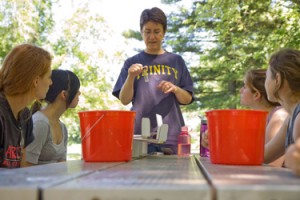Trinity College received a grant from the Connecticut Health and Educational Facilities Authority (CHEFA) aimed at strengthening curriculum and interest in biomedical sciences. Associate Professor of Engineering Harry Blaise ’94 (Trinity College), Assistant Professor of Biomedical Engineering Cater Arico (University of Hartford), and Magnet School Theme Coach Jerry Crystal (Capitol Region Education Council Academy of Aerospace and Engineering) served as project leaders.
The grant funded the BME-4-STEM program, BME referring to Biomedical Engineering and STEM signifying the accompanying skills of science, technology, engineering, and math. This initiative created and piloted an innovative middle school biomedical sciences curricula that was developed by college faculty, middle school educators, industry leaders, and undergraduate student STEM leaders, and may well be among the first such broad and collaborative approaches in biomedical sciences in the country.

In a training session at Trinity College this summer were: (L-R) Penny Kelly, science teacher at CREC Academy of Aerospace and Engineering; Harry Blaise, associate professor of engineering, Trinity College; Jerry Crystal, STEM coach, CREC Academy of Aerospace and Engineering; Marjahn Finlayson, science teacher, Talcott Mountain Science Academy; Joseph Palladino, professor of engineering, Trinity College; Jesscia Voight ’17, Trinity enigineering major; DavidJohn F. Douglas, science teacher at CREC Medical Professions Academy; Andrea Kwaczala, assistant professor of biomedical engineering, University of Hartford; Hugh Nguyen ’17, Trinity engineering major; Jonathan Craig, executive director of Talcott Mountain Science Center; Mary (Cater) Arico, assistant professor of biomedical engineering, University of Hartford; and invited speaker Ulrike Klueh, associate professor, UConn Health Center.
Through the creation of innovative lesson plans, experiments, and teacher training – first as a pilot program at a local level and ultimately replicated nationally – Blaise and his collaborators seek to educate and excite middle and eventually high school students about biomedical sciences. The project is part of the Hartford.Health.Works. (HHW) portfolio of programs. HHW is the brainchild of BEACON (Biomedical Engineering Alliance and Consortium), Rising-Tide Healthcare, and Movia Robotics. The goal of HHW is to leverage the city’s existing healthcare and technology infrastructure to drive STEM education, entrepreneurism, medical device manufacturing, and workforce development in the city of Hartford. Trinity College joined HHW as the lead education partner, and this is the first grant-funded programmatic initiative.
Crystal recruited local middle school teachers to participate in the summer program, and Arico’s responsibilities included industry outreach as well as curricula development. Both Blaise and Arico recruited engineering faculty and STEM undergraduate student leaders to teach the material to educators during the STEM Teacher Academy. According to Blaise, students from the Metropolitan Learning Center, a CREC school in Bloomfield, Talcott Mountain Science Center, and the Hartford Youth Scholars summer program participated in the program. In addition, “Trinity and University of Hartford students were involved during all phases of the program, including serving as teaching assistants, lab assistants, and program evaluation assistants,” he said.
The grant supported a number of students and teachers interested in biomedical engineering coursework and careers. Blaise recognized the dearth of such curriculum nationwide, especially in low-income school systems like Hartford. Partnering with CREC and programs such as Hartford Youth Scholars allowed BME-4-STEM to reach underserved students.
Blaise, whose current research is focused on the effects of caffeine on memory at the neuronal and synaptic levels, can still recall his own childhood encounters with science, showing that early exposure can often spark a deeper interest. “I built a very crude crystal AM radio when I was about 9 or 10,” he said. “I remember it working, although I was only able to receive one station. Later on, when I was in high school, I used to watch the PBS TV series, The Mechanical Universe. It was a documentary-style show covering geometry, trigonometry, and physics… That was about the time I decided to pursue a career in the STEM field.”
Written by Ursula Paige Granirer ’17













